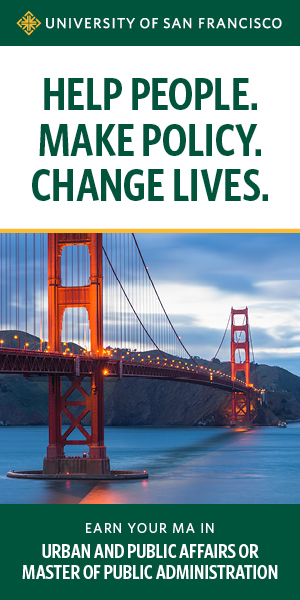As the supes started hearings on the Lurie Administration’s budget proposals today, the People’ Budget Coalition released a list of where some $600 million worth of cuts and budget redirections would hit hardest.
You can see the list here. It’s alarming to see how many public services that vulnerable communities rely on are on the chopping block.
Sup. Connie Chan, who chairs the Budget and Appropriations Committee, said at the first hearing today that the city has too many high-paid managers:
The reality is that Mayor Daniel Lurie inherited a city government that has grown at an unprecedented rate in the past five years – with management hiring at two times that of line workers leading to a top-heavy workforce and overworked front line city workers.
But the budget cuts facing community-based organizations and nonprofits that handle a lot of the city’s critical services are not “chopping from the top.” They are overwhelmingly hitting at the lowest-paid and in some cases most critical workers and programs.
For example, cuts to programs providing legal services to low-income people would impact:
AIDS Legal Referral Panel, Asian Law Caucus, Bay Area Legal Aid, Instituto Laboral de la Raza, Justice & Diversity Center of the Bar, LegalLink, Mujeres Unidas y Activas, Open Door Legal, and PRC
Cuts to gender-based healthcare, outreach, trafficking, and reentry services would devastate:
Community Forward SF (A Woman’s Place), Freedom Forward (HYPE Center 85% reduction), Lyon-Martin (St James Infirmary – Naughty Nurse Mobile), and Young Women’s Freedom Center (Beyond Survival)
A program that helps low-income, often monolingual tenants with code-enforcement issues is going away, harming
Chinatown Community Development Center, Housing Rights Committee of San Francisco, Mission Action, SOMCAN, Chinese Progressive Association, San Francisco Anti-Displacement Coalition, SRO Collaboratives, Tenderloin Housing Clinic
The city will no longer fund the only program of its kind that helps low-income workers fight wage theft.
Free City College will take a 23 percent cut. The list goes on.
Then there’s a cut of more than 300 workers at Muni, and a significant reduction in service—just as Muni ridership is coming close to pre-pandemic levels. That’s happening as Uber and Waymo seek to privatize public transit.

Critics are calling this the Billionaire’s Budget, because it hurts the poor and the middle class, while keeping the city safe for the very rich.
Just to put this in perspective, as Congress considers a budget that would make permanent massive tax cuts for the wealthy, let’s look at a little math.
An exceptionally helpful person at the IRS press office (times being what they are, I am not going to publish her name) helped me navigate the agency website, which has some interesting data about San Francisco.
In 2022, the most recent year that the data is public, 93,710 households in the city filed tax returns with income of more than 200,000. That’s 21 percent of all filers.
The IRS doesn’t break down the data beyond “more than $200,000,” but others do, including the payroll company ADP. According to its estimates, reported in the Chron, about .15 percent of the households in the San Francisco-Oakland-Fremont Standard Metropolitan Statistical Area earned more than $2 million last year. Another .5 percent earned more than $1 million, and 2.5 percent earned more than $500,000.
The SMSA includes Alameda, Marin, and San Mateo Counties, as well as San Francisco, and totals 4.6 million people. There are a lot of high earners in Marin and San Mateo, fewer in Alameda. Since the data is not perfect, we are going to have to make some estimates.
San Francisco makes up 17 percent of the population in the SMSA. Since we know there are more than 50 billionaires in this city, and parts of Marin and San Mateo are not home to the top 1 percent, I’m going to apportion the very rich according to our share of the population, which almost certainly undercounts the wealth in San Francisco.
By that math, 1,173 households in San Francisco earned more than $2 million, 3,900 earned more than $1 million, and about 19,000 took home more than $500,000.
Again, this grossly underestimates the wealth in the city, since this data tracks only payroll, and much of the money that the very rich take in every year comes from investments and non-payroll income. (Thomas Piketty points out that the money earned by rich people from return on existing wealth far exceeds the growth in the GDP—and wages—in almost every industrialized country today).
So let’s accept that this is a low, low estimate.
Next: If we just take the 5,073 San Francisco households with earned income of more than $1 million, and we again make a very, very conservative assumption that the average take-home pay is $1.5 million, those folks made $7.6 billion last year.
Based on Congressional Budget Office estimates, the tax savings on that money under the Trump tax cuts is about $451 million.
Guess what: Over two years, that’s $902 million—more than the two-year local budget deficit.
I just got a text message from my old pal Gavin Newsom. It wasn’t personal; I’m on some kind of list and he’s trying to raise money. It asked: “Is there anything I can say to convince you to donate to help me fight back against the attacks and threats from the Trump Administration?”
Yeah, there is: California had, according to the IRS, 1.9 million households filing tax returns of more than $200,000. Let’s leave most of them alone, and just go for the 5 percent or so who are in the million-plus bracket. That, by a rough estimate, is 95,000 households, who have saved at least $8.5 billion from the Trump tax cuts. That estimate is probably off by a factor of ten, since I’m only counting income.
Newsom was only partly joking when he said that California sends $80 billion more to the federal government in tax money than we get back, and “maybe that has to stop.” The federal income tax money doesn’t go through the state, so Newsom has no control over it.
But he and the Legislature do have control over the state income tax, and could adjust it to take a lot of that money back. He could use that surplus to help cities like San Francisco.
Or he and the Legislature could pass a bill allowing local governments to tax the rich on their own.
In other words: We don’t have a budget crisis. We have a tax and revenue crisis. And it’s not that hard to fix.
Instead, Lurie is talking about “tightening our belts.” I hate that metaphor: It means you’re not getting enough to eat. There’s no reason any poor or working-class person in San Francisco needs to go hungry, or be unable to get to work on Muni, or lack basic legal services, or building code enforcement.
But that’s what this Billionaire Budget is all about.
There are ways to impose city income taxes now; not perfect, but the state Supreme Court says we can tax “income earned in San Francisco.” San Franciscans who work in Silicon Valley wouldn’t have to pay, which is unfair and imperfect—but remote workers who live outside the city but work for local companies probably would. We could exempt the first $500,000 (or pick another number) and just hit the top end. It’s better than what we have now.
Changing state law to allow a proper income tax would be difficult. I know that.
But at a time when income inequality is an existential crisis (and a major reason Trump is in office) I wish someone at City Hall would at least talk about it.




